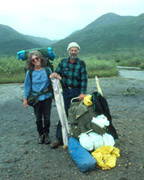Another Success Story at Channel Island National Park
©Bert Gildart: Twenty five years ago I was camped on San Miguel, a small island just off the coast of Ventura, California, which comprises a portion of the Channel Island National Park. Dusk was settling in over this Pacific Coast setting and, suddenly, amidst the veil of oceanic fog and roar of thousands of elephant seals, a tiny fox poked its head around the edge of my tent. Moments later, another materialized, then yet another.
At the time I was gathering material for Smithsonian Magazine on the return of the elephant seal and the park stipulated that I be accompanied to the island by a biologist. He informed me that these foxes were rare and were unique only to the Channel Islands.
Today (literally), the species is much in the news, and all this past week Janie and I have been reading and hearing news reports that the species has recovered from some exceedingly difficult times.
In fact, the recovery has been so successful that a creature thought near the brink of extinction may genuinely warrant being removed from the Endangered Species List.
SUCCESS STORY
The recover of the foxes has many components to its story. In large measure it is due to the successful breeding program scientists have conducted on the islands and to the removal of golden eagles, which had replaced bald eagles following their die-off resulting from the use of DDT.
Park biologists say that, initially, it was the sudden shuffle in the food chain that nearly wiped out the four subspecies of island foxes native to this park–and to this park alone. Though each of the island foxes can inter-breed all have characteristics that differentiate them one from the other. All, however, were adversely affected when golden eagles moved in.
The Santa Barbara Independent, which has covered the story extensively, reports that bald eagles lived on fish and posed no threat. Goldens, however, “… [dined] on the islands’ non-native feral pigs and on the island foxes, which made for pitifully easy prey as they had never before had to think about aerial predators.”
All that changed about 10 years ago when park biologists relocated the golden eagles and reintroduced bald eagle. As well, the park initiated a breeding program using captive foxes, which they caged on the islands for protection. Then, over the decade, they released them.
ISLANDS BOAST MANY SUCCESS STORIES
That the recovery has been a success is told in the tally of numbers. Just 10 years ago the number of foxes on San Miguel was tallied at 70, with even lower number on the park’s other five islands of Anacapa, Santa Cruz, Santa Rosa, and San Miguel, and Santa Barbara. Today, because of the breeding program the number on San Miguel, the largest of the islands, now number 410.
Interestingly, the Channel Islands have been the focus of a number of success stories, and one of the biggest was the part they played in the recovery of the elephant seal. Last week, in fact, before I was aware of this most recent success story, I had intended to post a blog about elephant seals, but the story about the fox seemed more timely. Consequently, elephant seals will be the subject of my next post.
In the meantime, I must say I am delighted to know that should I return with Janie to these islands, that the Channel Island fox is one of the mammals we might see. Set against the din of thousands of pinnipeds roaring as banks of fog rise off the Pacific Ocean, the sight of a Channel Island fox still peering around a corner of our tent would complete the magic of this primordial setting.
Other Subjects: One of the reasons I write blogs is because of the interesting feedback I sometimes get, in this case, an extraordinarily touching comment on one man’s personal involvement with another tragedy associate with the Francisco Morazan.
The Morazan was a freighter and in 1960, gigantic waves washed it ashore. The man’s thoughts clear up a mystery that still lingers and in so doing round out a bit of history associated with Michigan’s Sleeping Bear Dunes National Lakeshore. Janie and I are most appreciative that Mr. Kramer would share his experience.
I also write blogs as I can express my opinion on subjects I believe important. In the weeks ahead I’ll be committing on George Bush’s reversal on gun restrictions in national parks. “Mr. Bush,” I’d like to ask, “what possible benefits will be afforded park wildlife and park visitors by allowing some to bring in their firearms? Ronald Reagan didn’t think it a good idea, and you claim to have admired him.”
Park rangers eschew the relaxation on guns in national parks, saying it will make their jobs extremely difficult. Bush’s lifting of the ban is something I wrote (link in previous paragraph) about this summer, and in the weeks ahead I’ll be adding to those initial thoughts. From my years in Glacier as a seasonal park ranger I still have friends working in national parks, and I’m hoping to get their input. Perhaps there are other aspects to this story about which I’m not aware.





December 17th, 2008 at 7:19 pm
This is great news Bert! What a beautiful animal. It’s hearing stories like this that make me believe we can make a difference on this earth. Thank you for posting this!